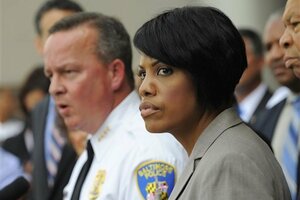Federal agents called to Baltimore to quell rising violence
Over 40 people were killed in Baltimore in July, making it the city’s deadliest month in decades.

Baltimore Mayor Stephanie Rawlings-Blake and other elected officials announce the start of the Baltimore Federal Homicide Task Force, Monday, Aug. 3, 2015, in Baltimore.
Lloyd Fox/The Baltimore Sun via AP
Baltimore’s crime rate has soared since an unarmed black man named Freddie Gray died in police study in May, sparking riots across the city. In hopes to quell the violence, ten federal agents will join Baltimore’s local police forces, to create the B-FED Task Force.
"We've got the whole country on the side of Baltimore to make these streets safe,” Maryland Sen. Barbara Mikulski said during a news conference announcing the initiative Monday afternoon.
Special agents from the FBI; the Drug Enforcement Agency; the Bureau of Alcohol, Tobacco, Firearms, and Explosives; the US Marshals Service and the US Secret Service will work with local officers in what Interim Police Commissioner Kevin Davis describes as a "flipping of the script of sorts,” reports the Baltimore Sun.
Bringing federal forces into local police departments is an “unusual” arrangement, Mr. Davis said, because federal agencies usually seek the help of local detectives on a particular long-term investigation. But under the B-FED Task Force, the ten new agents will use federal resources to help homicide detectives solve killings.
“We’re going to come up with some innovative ways to bring criminal charges against people who are harming our community,” he said, by focusing on a “small number of highly-motivated violent repeat offenders.”
The new officials will join 20 agents from the Bureau of Alcohol, Tobacco, and Firearms, who have already been working on cases with the local department's Ceasefire detectives, along with a full-time FBI analyst assigned to the analytical intelligence section, Davis said.
Baltimore has been dealing with an exceptional rise in violence this year. A total of 191 people have been killed so far, and at least 116 of them died between May and July following the Freddie Gray riots, the Associated Press reports. The city had never before seen more than 40 killings within the span of two months. Yet the 45 deaths in July matched the Baltimore's all-time monthly high from 1972, when the city had 275,000 more residents, reports the Baltimore Sun.
Rising gun violence has been a pressing issue. Officers confiscated about 20 percent more guns on the street this year than the same time last year, said Davis.
Police believe a recent of “atmosphere of uncertainty” may be causing more residents to arm themselves, but according to the Associated Press, crime experts and residents of Baltimore’s most dangerous neighborhoods point to a number of explanations: “mistrust of the police; generalized anger and hopelessness over a lack of opportunities for young black men; and competition among dealers of illegal drugs, bolstered by the looting of prescription pills from pharmacies during the riot.”
Though the surge in violence stands out in Baltimore, Davis says the city is one of many that has faced a rise in killings this year. "Certainly it's pronounced here in Baltimore, but I believe the circumstances contributing to our uptick are probably not unlike the circumstances contributing to the uptick in homicides in other jurisdictions across our country," Davis said.
He referred to rising crime in cities like New York, where fatal shootings are up 20 percent so far this year, and Milwaukee, which has seen triple-digit percentage increases, The Christian Science Monitor reported.
Though criminal justice experts say these numbers shouldn’t alarm the public, Washington plans to tackle the causes and solutions of growing violence during a summit of top police officers this week.

